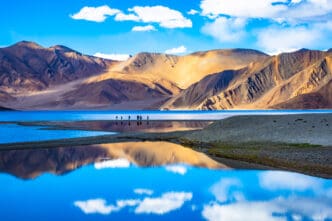Your Essential Overview
- The Taj Mahal is a UNESCO World Heritage site, globally recognized as a symbol of eternal love and a pinnacle of Mughal architecture, built by Emperor Shah Jahan.
- The optimal time to visit is during the cooler months from October to March, ideally at sunrise or sunset, with online ticket purchase and using the East Gate for pre-booked tickets recommended for a smoother entry.
- The complex features a symmetrical Charbagh garden and intricate marble inlay work, with photography restricted inside the main mausoleum, and visitors should plan for rigorous security checks and general travel tips like modest dress and hydration.
The Destination’s Lore
- The Taj Mahal, a UNESCO World Heritage site in Agra, India, was commissioned by Emperor Shah Jahan between 1631 and 1653 as an opulent white marble mausoleum for his beloved wife, Mumtaz Mahal, following her death. This architectural marvel represents the pinnacle of Mughal design, harmoniously blending Persian, Islamic, and Indian styles, and stands today as a globally recognized symbol of eternal love and artistic brilliance, making it a primary draw for millions of international visitors.
Making the Trip Yours
- The Taj Mahal’s enduring status as a UNESCO World Heritage site and global symbol of love continues to draw millions, making meticulous planning essential for visitors to navigate its logistics and optimize their experience. This iconic attraction also serves as a gateway to exploring Agra’s wider historical treasures, thereby enriching the overall travel experience and boosting regional tourism.
Perspectives from the Road
- The article advises that careful planning regarding optimal timing, intricate logistics, and what to expect is paramount for travelers to ensure a truly seamless and unforgettable experience at the Taj Mahal.
- Emperor Shah Jahan commissioned the Taj Mahal as a final resting place for his beloved wife Mumtaz Mahal, intending it as a monumental undertaking showcasing profound devotion and artistic brilliance.
- UNESCO and the global community recognize the Taj Mahal as a World Heritage site and a globally recognized symbol of eternal love and architectural grandeur, captivating hearts with its romantic narrative and unparalleled aesthetic appeal.

Embarking on an Indian adventure often culminates in a visit to the breathtaking Taj Mahal, a globally recognized symbol of eternal love and architectural grandeur. This iconic white marble mausoleum, commissioned by Emperor Shah Jahan in memory of his beloved wife Mumtaz Mahal, stands majestically in Agra, Uttar Pradesh, India. Millions of travelers, history enthusiasts, and romantics from around the world flock to this UNESCO World Heritage site annually to witness its unparalleled beauty and delve into its rich history. Understanding the optimal time to visit, how to navigate its intricate logistics, and what to expect will ensure a truly seamless and unforgettable experience.
The Enduring Legacy of the Taj Mahal
The Taj Mahal’s story is one of profound devotion and artistic brilliance. Built between 1631 and 1653, it was conceived by Emperor Shah Jahan as a final resting place for his wife, Mumtaz Mahal, who died giving birth to their 14th child. This monumental undertaking involved thousands of artisans and craftsmen, showcasing the pinnacle of Mughal architecture.
Architecturally, the Taj Mahal is a harmonious blend of Persian, Islamic, and Indian styles. Its perfect symmetry, intricate marble inlay work featuring precious and semi-precious stones, and the ethereal glow of the white marble at different times of the day are simply mesmerizing. The entire complex, including the main mausoleum, mosque, guest house, and gardens, is a testament to sophisticated design and engineering from the 17th century.
Recognized as a UNESCO World Heritage site since 1983, the Taj Mahal is not merely a tomb but a poetic expression in stone, captivating hearts with its romantic narrative and unparalleled aesthetic appeal. Its global recognition solidifies its status as a must-visit destination for anyone exploring India’s rich cultural tapestry.

Planning Your Visit: When and How to Go
Careful planning is paramount for a truly enjoyable and hassle-free Taj Mahal experience. Factors like weather, crowd levels, and transportation should be considered well in advance.
Best Time to Visit
The ideal time to visit the Taj Mahal and Agra is during the cooler, drier months from October to March. Temperatures are pleasant, making sightseeing comfortable. Avoiding the scorching heat of summer (April to June) and the heavy monsoon rains (July to September) is highly recommended for a more enjoyable trip.
Regarding the time of day, sunrise visits are highly popular for a reason. The soft, golden light illuminates the marble, creating a magical glow, and the crowds are generally thinner. Sunset also offers a beautiful spectacle, though it tends to be more crowded. Mid-day can be very hot and busy, so plan accordingly.
Getting to Agra
Agra is well-connected to major Indian cities, especially Delhi, making it an accessible destination. The most popular way to reach Agra from Delhi is by train.
The Gatimaan Express and Shatabdi Express are excellent choices, offering comfortable and fast journeys, taking approximately 2-3 hours. Private car hires with a driver are another convenient option, providing flexibility and door-to-door service, typically taking 3-4 hours depending on traffic. Buses are also available but generally take longer.
Entry Tickets and Gates
It is highly advisable to purchase your entry tickets online through the official Archaeological Survey of India (ASI) website in advance. This saves time and often allows for a dedicated entry queue. International visitor tickets are priced differently from domestic ones, and children under 15 often enter for free.
There are three main entry gates to the Taj Mahal complex: the West Gate, the East Gate, and the South Gate. The West Gate is the most popular, often leading to longer queues. The East Gate is typically used by tourists who have pre-booked tickets and often has shorter lines. The South Gate primarily serves local visitors and closes earlier in the day. Be prepared for rigorous security checks at all entry points; large bags, food, and electronics other than cameras and phones are generally not allowed inside.
Navigating the Site: What to Expect Inside
Once inside the complex, a sense of awe is almost immediate. The sheer scale and beauty are overwhelming, offering a journey through history and art.
The Main Complex
Upon entering through the magnificent Darwaza-i Rauza, or Great Gate, visitors are greeted by the vast Charbagh (four-part garden), designed in the Persian style. This symmetrical garden features pathways, fountains, and reflecting pools that perfectly frame the Taj Mahal, leading the eye directly to the main mausoleum.
The central mausoleum itself is the epitome of Mughal architecture. Constructed from pristine white Makrana marble, it is adorned with intricate pietra dura inlay work, where thousands of precious and semi-precious stones form delicate floral patterns and calligraphic inscriptions. Inside, the cenotaphs of Shah Jahan and Mumtaz Mahal lie in a central chamber, though their actual graves are in a crypt below. Photography is generally restricted inside the main mausoleum, preserving its sanctity and preventing damage from flash photography.
Flanking the main mausoleum are two identical red sandstone buildings: a mosque to the west and a guesthouse (Jawab) to the east. These structures maintain the perfect symmetry of the complex and offer excellent vantage points for viewing the Taj Mahal.
Photography Tips
Capturing the Taj Mahal’s splendor is a highlight for many visitors. For the best photographs, consider shooting during the golden hours of sunrise or sunset when the light is soft and warm. The reflecting pools in the Charbagh garden offer iconic mirror-image shots. Experiment with different angles and perspectives from various points within the complex, including the mosque and guesthouse. Remember to respect photography restrictions, especially inside the mausoleum.
Beyond the Taj: Exploring Agra
While the Taj Mahal is undoubtedly the star attraction, Agra and its surroundings boast other significant historical sites that enrich the travel experience.
Agra Fort
A short distance from the Taj Mahal, the Agra Fort is another UNESCO World Heritage site and a formidable Mughal fortress. This red sandstone fort served as the main residence of the emperors of the Mughal Dynasty until 1638. Its impressive walls enclose numerous palaces, halls, and mosques, offering a glimpse into the opulent lives of the Mughals. From its ramparts, you can even catch a distant view of the Taj Mahal, which Shah Jahan reportedly gazed upon during his imprisonment here.
Fatehpur Sikri
Approximately an hour’s drive from Agra lies Fatehpur Sikri, a fascinating ghost city built by Emperor Akbar in the 16th century. This well-preserved complex served as the Mughal capital for a brief period before being abandoned due to water scarcity. Its magnificent palaces, courtyards, and the grand Buland Darwaza gate showcase exquisite Mughal architecture and provide a deeper understanding of the empire’s grandeur.
Mehtab Bagh (Moonlight Garden)
For a different perspective of the Taj Mahal, visit Mehtab Bagh, a Mughal garden located directly across the Yamuna River. This tranquil garden offers stunning, unobstructed views of the Taj Mahal, especially at sunset, making it a perfect spot for photography and peaceful reflection away from the main crowds.
Local Cuisine and Shopping
No visit to Agra is complete without sampling its local delicacies. Be sure to try “petha,” a famous translucent soft candy made from ash gourd, available in various flavors. Agra is also renowned for its marble inlay work, a craft that mirrors the intricate designs found on the Taj Mahal. You can find beautiful souvenirs, leather goods, and traditional Indian clothing in the local markets.
Essential Travel Tips for a Seamless Experience
To ensure your Indian adventure is as smooth as possible, keep these practical tips in mind.
Choose your accommodation wisely, ranging from luxury hotels to budget-friendly guesthouses, based on your preferences and proximity to attractions. Dress modestly, especially when visiting religious sites, and wear comfortable walking shoes as you’ll be doing a lot of exploring. While official guides can enhance your understanding of the sites, be wary of unofficial touts.
Stay hydrated, especially during warmer months, by carrying bottled water. Protect yourself from the sun with hats, sunglasses, and sunscreen. Be aware of common tourist scams and always agree on prices before committing to services like rickshaw rides. Carry sufficient local currency (Indian Rupees) for smaller purchases, though major establishments accept cards. Finally, ensure your phone has connectivity for navigation and emergencies.
A journey to the Taj Mahal is more than just a sightseeing trip; it is an immersion into a timeless narrative of love, art, and history. By planning meticulously and embracing the local culture, travelers can unlock a truly seamless and profoundly moving Indian adventure, leaving with memories of one of the world’s most magnificent wonders.








